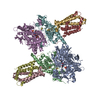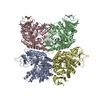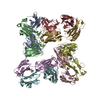[English] 日本語
 Yorodumi
Yorodumi- EMDB-1788: Doublecortin-stabilised microtubules at secondary structure resolution -
+ Open data
Open data
- Basic information
Basic information
| Entry | Database: EMDB / ID: EMD-1788 | |||||||||
|---|---|---|---|---|---|---|---|---|---|---|
| Title | Doublecortin-stabilised microtubules at secondary structure resolution | |||||||||
 Map data Map data | This is the corner between 4 tubulin dimers bound by doublecortin, in 13-protofilament microtubules | |||||||||
 Sample Sample |
| |||||||||
 Keywords Keywords | Tubulin / MAP / microtubule / stabilisation / doublecortin | |||||||||
| Function / homology |  Function and homology information Function and homology informationaxoneme assembly / Neurofascin interactions / positive regulation of axon guidance / microtubule associated complex / microtubule-based process / central nervous system development / structural constituent of cytoskeleton / microtubule cytoskeleton organization / neuron migration / nervous system development ...axoneme assembly / Neurofascin interactions / positive regulation of axon guidance / microtubule associated complex / microtubule-based process / central nervous system development / structural constituent of cytoskeleton / microtubule cytoskeleton organization / neuron migration / nervous system development / mitotic cell cycle / microtubule cytoskeleton / retina development in camera-type eye / microtubule binding / Hydrolases; Acting on acid anhydrides; Acting on GTP to facilitate cellular and subcellular movement / microtubule / cytoskeleton / neuron projection / intracellular signal transduction / hydrolase activity / protein heterodimerization activity / GTPase activity / protein kinase binding / GTP binding / metal ion binding / cytosol / cytoplasm Similarity search - Function | |||||||||
| Biological species |   Homo sapiens (human) Homo sapiens (human) | |||||||||
| Method | helical reconstruction / cryo EM / negative staining / Resolution: 8.2 Å | |||||||||
 Authors Authors | Fourniol FJ / Sindelar CV / Amigues B / Clare D / Thomas G / Perderiset M / Francis F / Houdusse A / Moores CA | |||||||||
 Citation Citation |  Journal: J Cell Biol / Year: 2010 Journal: J Cell Biol / Year: 2010Title: Template-free 13-protofilament microtubule-MAP assembly visualized at 8 A resolution. Authors: Franck J Fourniol / Charles V Sindelar / Béatrice Amigues / Daniel K Clare / Geraint Thomas / Mylène Perderiset / Fiona Francis / Anne Houdusse / Carolyn A Moores /  Abstract: Microtubule-associated proteins (MAPs) are essential for regulating and organizing cellular microtubules (MTs). However, our mechanistic understanding of MAP function is limited by a lack of detailed ...Microtubule-associated proteins (MAPs) are essential for regulating and organizing cellular microtubules (MTs). However, our mechanistic understanding of MAP function is limited by a lack of detailed structural information. Using cryo-electron microscopy and single particle algorithms, we solved the 8 Å structure of doublecortin (DCX)-stabilized MTs. Because of DCX's unusual ability to specifically nucleate and stabilize 13-protofilament MTs, our reconstruction provides unprecedented insight into the structure of MTs with an in vivo architecture, and in the absence of a stabilizing drug. DCX specifically recognizes the corner of four tubulin dimers, a binding mode ideally suited to stabilizing both lateral and longitudinal lattice contacts. A striking consequence of this is that DCX does not bind the MT seam. DCX binding on the MT surface indirectly stabilizes conserved tubulin-tubulin lateral contacts in the MT lumen, operating independently of the nucleotide bound to tubulin. DCX's exquisite binding selectivity uncovers important insights into regulation of cellular MTs. | |||||||||
| History |
|
- Structure visualization
Structure visualization
| Movie |
 Movie viewer Movie viewer |
|---|---|
| Structure viewer | EM map:  SurfView SurfView Molmil Molmil Jmol/JSmol Jmol/JSmol |
| Supplemental images |
- Downloads & links
Downloads & links
-EMDB archive
| Map data |  emd_1788.map.gz emd_1788.map.gz | 104 KB |  EMDB map data format EMDB map data format | |
|---|---|---|---|---|
| Header (meta data) |  emd-1788-v30.xml emd-1788-v30.xml emd-1788.xml emd-1788.xml | 13.6 KB 13.6 KB | Display Display |  EMDB header EMDB header |
| Images |  EMD-1788.png EMD-1788.png | 315.8 KB | ||
| Archive directory |  http://ftp.pdbj.org/pub/emdb/structures/EMD-1788 http://ftp.pdbj.org/pub/emdb/structures/EMD-1788 ftp://ftp.pdbj.org/pub/emdb/structures/EMD-1788 ftp://ftp.pdbj.org/pub/emdb/structures/EMD-1788 | HTTPS FTP |
-Validation report
| Summary document |  emd_1788_validation.pdf.gz emd_1788_validation.pdf.gz | 203.3 KB | Display |  EMDB validaton report EMDB validaton report |
|---|---|---|---|---|
| Full document |  emd_1788_full_validation.pdf.gz emd_1788_full_validation.pdf.gz | 202.5 KB | Display | |
| Data in XML |  emd_1788_validation.xml.gz emd_1788_validation.xml.gz | 4.3 KB | Display | |
| Arichive directory |  https://ftp.pdbj.org/pub/emdb/validation_reports/EMD-1788 https://ftp.pdbj.org/pub/emdb/validation_reports/EMD-1788 ftp://ftp.pdbj.org/pub/emdb/validation_reports/EMD-1788 ftp://ftp.pdbj.org/pub/emdb/validation_reports/EMD-1788 | HTTPS FTP |
-Related structure data
| Related structure data |  2xrpMC  1787C M: atomic model generated by this map C: citing same article ( |
|---|---|
| Similar structure data |
- Links
Links
| EMDB pages |  EMDB (EBI/PDBe) / EMDB (EBI/PDBe) /  EMDataResource EMDataResource |
|---|---|
| Related items in Molecule of the Month |
- Map
Map
| File |  Download / File: emd_1788.map.gz / Format: CCP4 / Size: 319.3 KB / Type: IMAGE STORED AS FLOATING POINT NUMBER (4 BYTES) Download / File: emd_1788.map.gz / Format: CCP4 / Size: 319.3 KB / Type: IMAGE STORED AS FLOATING POINT NUMBER (4 BYTES) | ||||||||||||||||||||||||||||||||||||||||||||||||||||||||||||||||||||
|---|---|---|---|---|---|---|---|---|---|---|---|---|---|---|---|---|---|---|---|---|---|---|---|---|---|---|---|---|---|---|---|---|---|---|---|---|---|---|---|---|---|---|---|---|---|---|---|---|---|---|---|---|---|---|---|---|---|---|---|---|---|---|---|---|---|---|---|---|---|
| Annotation | This is the corner between 4 tubulin dimers bound by doublecortin, in 13-protofilament microtubules | ||||||||||||||||||||||||||||||||||||||||||||||||||||||||||||||||||||
| Projections & slices | Image control
Images are generated by Spider. generated in cubic-lattice coordinate | ||||||||||||||||||||||||||||||||||||||||||||||||||||||||||||||||||||
| Voxel size | X=Y=Z: 2.8 Å | ||||||||||||||||||||||||||||||||||||||||||||||||||||||||||||||||||||
| Density |
| ||||||||||||||||||||||||||||||||||||||||||||||||||||||||||||||||||||
| Symmetry | Space group: 1 | ||||||||||||||||||||||||||||||||||||||||||||||||||||||||||||||||||||
| Details | EMDB XML:
CCP4 map header:
| ||||||||||||||||||||||||||||||||||||||||||||||||||||||||||||||||||||
-Supplemental data
- Sample components
Sample components
-Entire : Microtubules co-polymerised with doublecortin
| Entire | Name: Microtubules co-polymerised with doublecortin |
|---|---|
| Components |
|
-Supramolecule #1000: Microtubules co-polymerised with doublecortin
| Supramolecule | Name: Microtubules co-polymerised with doublecortin / type: sample / ID: 1000 / Oligomeric state: 13-protofilament microtubule / Number unique components: 2 |
|---|
-Macromolecule #1: Tubulin alpha-1D chain
| Macromolecule | Name: Tubulin alpha-1D chain / type: protein_or_peptide / ID: 1 / Name.synonym: Alpha Tubulin / Oligomeric state: Heterodimer / Recombinant expression: No / Database: NCBI |
|---|---|
| Source (natural) | Organism:  |
| Sequence | InterPro: Alpha tubulin |
-Macromolecule #2: Tubulin beta-2B chain
| Macromolecule | Name: Tubulin beta-2B chain / type: protein_or_peptide / ID: 2 / Name.synonym: Beta Tubulin / Oligomeric state: Heterodimer / Recombinant expression: No / Database: NCBI |
|---|---|
| Source (natural) | Organism:  |
| Sequence | InterPro: Beta tubulin, autoregulation binding site |
-Macromolecule #3: Doublecortin
| Macromolecule | Name: Doublecortin / type: protein_or_peptide / ID: 3 / Name.synonym: DCX / Oligomeric state: Monomer / Recombinant expression: Yes |
|---|---|
| Source (natural) | Organism:  Homo sapiens (human) / synonym: Human / Location in cell: Cytoplasm Homo sapiens (human) / synonym: Human / Location in cell: Cytoplasm |
| Recombinant expression | Organism: Spodoptera frugiperda (Sf9) / Recombinant plasmid: pFastBac |
| Sequence | InterPro: Doublecortin domain |
-Experimental details
-Structure determination
| Method | negative staining, cryo EM |
|---|---|
 Processing Processing | helical reconstruction |
| Aggregation state | filament |
- Sample preparation
Sample preparation
| Buffer | pH: 6.8 Details: 80mM Pipes, 1mM EGTA, 3mM MgCl2, 1mM TCEP, 0.5mM GTP |
|---|---|
| Staining | Type: NEGATIVE / Details: cryo-EM |
| Grid | Details: 300 mesh lacey carbon grids |
| Vitrification | Cryogen name: ETHANE / Chamber humidity: 100 % / Instrument: OTHER / Details: Vitrification instrument: Vitrobot (FEI) / Method: Chamber at 37 degrees C, blot 2s |
- Electron microscopy
Electron microscopy
| Microscope | FEI TECNAI F20 |
|---|---|
| Temperature | Average: 93 K |
| Alignment procedure | Legacy - Astigmatism: Objective lens astigmatism was corrected at 150,000 times magnification |
| Image recording | Category: FILM / Film or detector model: KODAK SO-163 FILM / Digitization - Scanner: ZEISS SCAI / Digitization - Sampling interval: 7 µm / Number real images: 63 / Average electron dose: 15 e/Å2 / Details: Images were binned with a factor of 2 / Bits/pixel: 8 |
| Electron beam | Acceleration voltage: 200 kV / Electron source:  FIELD EMISSION GUN FIELD EMISSION GUN |
| Electron optics | Illumination mode: FLOOD BEAM / Imaging mode: BRIGHT FIELD / Cs: 2.0 mm / Nominal defocus max: 2.9 µm / Nominal defocus min: 0.76 µm / Nominal magnification: 50000 |
| Sample stage | Specimen holder: Eucentric / Specimen holder model: OTHER |
| Experimental equipment |  Model: Tecnai F20 / Image courtesy: FEI Company |
- Image processing
Image processing
| Final reconstruction | Algorithm: OTHER / Resolution.type: BY AUTHOR / Resolution: 8.2 Å / Resolution method: FSC 0.5 CUT-OFF / Software - Name: SPIDER, FREALIGN Details: Approximately 168,000 asymmetric units were averaged together in the final map |
|---|---|
| CTF correction | Details: done with FREALIGN |
-Atomic model buiding 1
| Initial model | PDB ID: |
|---|---|
| Software | Name: UCSF Chimera, Flex-EM |
| Details | Protocol: Rigid body. 4 tubulin monomers were fitted separately in 3D map, which was zoned around the subunits, and multiple subunit fitting was refined in Flex-EM |
| Refinement | Space: REAL / Protocol: RIGID BODY FIT / Target criteria: Cross-correlation |
| Output model |  PDB-2xrp: |
-Atomic model buiding 2
| Initial model | PDB ID: Chain - Chain ID: A |
|---|---|
| Software | Name: UCSF Chimera, Flex-EM |
| Details | PDBEntryID_givenInChain. Protocol: Rigid body. 4 tubulin monomers were fitted separately in 3D map, which was zoned around the subunits, and multiple subunit fitting was refined in Flex-EM |
| Refinement | Space: REAL / Protocol: RIGID BODY FIT / Target criteria: Cross-correlation |
| Output model |  PDB-2xrp: |
 Movie
Movie Controller
Controller














 Z (Sec.)
Z (Sec.) Y (Row.)
Y (Row.) X (Col.)
X (Col.)























